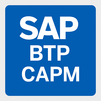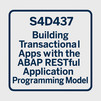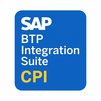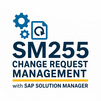
The SAP FSCD (Financial Services – Collections and Disbursements) course provides comprehensive training on managing collections, payments, dunning, and subledger accounting within the insurance and financial services industries. Participants will learn to configure contract accounts, handle incoming/outgoing payments, manage business partner data, and integrate FSCD with other SAP modules. This course is ideal for functional consultants, finance professionals, and system users aiming to streamline financial operations in SAP-based environments.
SAP FSCD Training Interview Questions Answers - For Intermediate
1. What is the role of the Business Partner (BP) in SAP FSCD?
In SAP FSCD, the Business Partner (BP) is a central master data object used to represent customers, brokers, or any party involved in financial transactions. It holds general information like name, address, and contact details and can have multiple roles such as contract partner, payer, or payee, enabling FSCD to handle diverse financial interactions flexibly.
2. How are returns processed in FSCD?
Returns in FSCD occur when a payment is reversed, such as a bounced direct debit. The system posts a return item, optionally applies return charges, and may trigger follow-up actions like dunning or correspondence. Return reasons and configurations control the behavior of return processing.
3. What is the use of the clearing control in FSCD?
Clearing control in FSCD determines how incoming payments are matched against open items. It defines clearing rules, tolerance groups, and payment priorities. It ensures that payments are allocated appropriately, minimizing residuals and discrepancies in customer accounts.
4. How do you configure dunning procedures in FSCD?
Dunning procedures are configured by defining dunning levels, intervals, forms, and charges. Each contract account is linked to a dunning procedure, which determines when and how the customer is reminded about overdue items, with increasing severity at each level.
5. What is the difference between individual value adjustment (IVA) and flat-rate value adjustment in FSCD?
IVA is a manual adjustment made for specific open items based on expected non-payment. Flat-rate adjustment is an automatic process applied to a group of items based on predefined percentages. Both help in risk provisioning and financial reporting.
6. What are the typical steps involved in payment run processing in FSCD?
A payment run in FSCD involves selecting due items, creating payment documents, generating payment media (e.g., direct debit files), and posting the payments. The process can be scheduled as a mass activity and includes pre-checks for authorizations and account status.
7. Explain the use of statistical items in FSCD.
Statistical items in FSCD are non-posting entries used for informational or reporting purposes. They don’t affect the contract account balance but may be used for internal tracking, such as expected future payments or pending settlements.
8. What is the role of master data templates in FSCD?
Master data templates simplify the creation of consistent contract accounts and business partner roles by predefining values like payment terms, dunning procedures, and account determination groups. They help ensure standardization and reduce manual errors during onboarding.
9. How is account determination handled in FSCD?
Account determination in FSCD defines how postings in the subledger are mapped to general ledger accounts. It uses rules based on transaction type, main/sub-transactions, and other attributes to ensure correct financial reporting and compliance with accounting standards.
10. What are the different types of items in FSCD?
FSCD classifies items as open, cleared, statistical, or temporarily posted. Open items represent outstanding receivables or payables, cleared items are settled, statistical items are for reference, and temporarily posted items await clarification before final posting.
11. How does FSCD handle tax calculations?
FSCD integrates with tax procedures to apply VAT or other taxes on premium payments. It supports both gross and net posting, and tax codes can be configured per transaction type, ensuring regulatory compliance in financial postings.
12. What is the purpose of document splitting in FSCD?
Document splitting allows detailed financial reporting by segmenting postings based on dimensions like profit center or business area. This enables more granular financial analysis and is crucial for organizations with diverse operations and regulatory requirements.
13. How are security deposits managed in FSCD?
Security deposits in FSCD are handled using special transaction types that segregate them from regular receivables. They can be posted, refunded, or applied against open items as needed, ensuring accurate tracking and compliance with contractual obligations.
14. What are incoming and outgoing payment methods in FSCD?
Incoming payment methods include direct debit, bank transfer, or check, while outgoing methods include credit transfer, payment via clearing house, or manual disbursement. FSCD allows you to define, configure, and assign these methods per contract account or BP.
15. How does SAP FSCD support audit and compliance requirements?
FSCD provides comprehensive audit trails, event history logs, and standard reports for regulatory compliance. Posting logs, reconciliation keys, and document flow tracking enable transparent financial processes aligned with local and international accounting standards.
SAP FSCD Training Interview Questions Answers - For Advanced
1. How does SAP FSCD support compliance with IFRS 17 and other international accounting standards?
SAP FSCD contributes to IFRS 17 compliance by enabling transparent, auditable subledger accounting that aligns with the requirements for insurance contract measurement, cash flow tracking, and revenue recognition. While FSCD does not directly calculate insurance liabilities under IFRS 17, it serves as a critical data source for insurance cash flows, including premiums, claims, and commissions. FSCD can integrate with SAP’s subledger accounting engine (FPSL) or SAP S/4HANA for Insurance to process actuarial inputs and accounting logic as required under IFRS 17. Features such as reconciliation keys, document history, posting area configurations, and custom event handling ensure that financial data from FSCD can be aggregated, categorized, and reported accurately for IFRS and other GAAP standards. FSCD’s robust audit trail, versioning, and change logs also support external audits and regulatory reviews.
2. How does SAP FSCD handle co-insurance and multi-party settlements?
Co-insurance involves multiple insurers sharing risk and revenue under a single policy. SAP FSCD handles co-insurance by assigning specific partner roles and percentages to each insurer in the policy record, often configured in integration with FS-PM or custom enhancements. The module ensures that receivables and payables are proportionally distributed among co-insurers during premium invoicing and claim settlements. Multi-party settlements are managed using account assignment references and business partner roles like payee, co-insurer, and reinsurer. Clearing and payment processes consider each party's share, with FSCD tracking each transaction's flow using sub-transactions. Complex cases such as reverse settlements or corrections are managed using events, manual adjustments, or clarification cases.
3. What is the role of dynamic dunning procedures in FSCD, and how can they be customized?
Dynamic dunning procedures in FSCD enable more flexible and customer-specific dunning based on real-time financial behavior, customer risk profiles, and business rules. Unlike static dunning, where fixed intervals and levels are applied, dynamic dunning evaluates open items, payment history, and thresholds to assign a dunning level per customer or contract account. FSCD allows the configuration of dunning variants, strategies, and triggers through the dunning procedure framework. Enhancements can be done using events or BAdIs to dynamically skip levels, change templates, or delay dunning for VIP clients or special conditions. This approach reduces customer dissatisfaction and aligns collection efforts with customer value and risk exposure.
4. Describe how SAP FSCD handles brokerage and commission management.
FSCD supports brokerage and commission management by tracking commissions payable to agents, brokers, and intermediaries for policies they manage. These payables are posted as open items in FSCD, linked to business partners assigned the broker role. Commissions can be calculated in FS-PM or externally, and then transferred into FSCD for disbursement, tracking, and reporting. FSCD enables features such as commission holdback, clawbacks for canceled policies, and mass payment runs for agents. It also supports advance commissions, tiered rates, and territory-specific rules. Through reconciliation keys, posting areas, and events, the entire commission process is auditable and customizable based on business agreements.
5. How can SAP FSCD be used in a multi-entity insurance company with shared services?
In a shared services model, SAP FSCD can support multiple insurance entities within the same system by using organizational units like company code, product, and business area. Master data can be shared or segregated, and posting rules can be configured per entity. Business transactions are isolated using account determination groups, posting areas, and reconciliation keys, ensuring financial separation while benefiting from centralized operations like dunning, payment processing, and correspondence. Multi-entity reporting, intercompany clearing, and financial consolidation are also supported via integration with SAP S/4HANA FI and SAP Group Reporting. Role-based access and data authorizations ensure data security in this setup.
6. What are alternative clearing methods in FSCD and when should they be used?
Alternative clearing methods in FSCD allow different approaches to match incoming payments with open items beyond standard payment reference matching. These include clearing by document number, assignment reference, contract account, or even customer-specific attributes. Alternative clearing is configured in the clearing control and can be tailored for specific scenarios such as bulk payments, bank transfers without reference, or third-party remittances. It is particularly useful when integrating with external billing systems or when payment data is inconsistent. Clearing variants and search strategies are defined to prioritize how the system attempts to match items, improving clearing efficiency and reducing manual intervention.
7. How does FSCD manage tax handling and compliance in cross-border operations?
In cross-border insurance operations, FSCD manages tax handling through flexible tax calculation procedures that support VAT, GST, and insurance premium taxes (IPT). Taxes can be calculated based on the product, service location, and customer country using tax codes and jurisdiction rules. Integration with SAP SD or third-party tax engines like Vertex or Thomson Reuters can enhance accuracy. FSCD posts tax amounts separately, supports reporting for tax authorities, and ensures compliance with local and international tax regulations. It also handles tax exemptions, reverse charge mechanisms, and changes in tax legislation, which are critical in global insurance operations.
8. Explain the relevance of product modeling in FSCD and its influence on transaction processing.
Product modeling in FSCD involves defining financial behavior for insurance products—such as billing frequencies, payment plans, dunning preferences, and commission structures. Products are linked to contract accounts and business partner roles, and drive how receivables are generated and processed. This modeling allows insurers to create standardized yet flexible financial logic across product lines. During transaction processing, the product definition influences the transaction type, posting rules, and correspondence formats. This supports automation and reduces the need for manual configuration per policy, making product modeling a key enabler of scalable FSCD implementation.
9. How does FSCD handle suspense accounts and unidentified payments?
Suspense accounts in FSCD temporarily hold incoming payments that cannot be directly matched to open items due to missing references, partial amounts, or overpayments. Such payments are routed to suspense accounts via clarification cases, and users analyze and allocate them correctly. Suspense postings are controlled by special G/L accounts and monitored through aging reports and exception handling tools. FSCD also allows configuration of thresholds, auto-matching rules, and follow-up actions (e.g., refund, write-off, or customer notification) to manage these balances efficiently. Proper suspense management is crucial for financial transparency and compliance.
10. How is cash flow forecasting supported in FSCD?
FSCD supports cash flow forecasting by tracking due items, installment plans, expected payments, and payment patterns. The system aggregates due dates and payment behavior data to estimate inflows and outflows over a defined horizon. Forecasting tools can be integrated with SAP BW, SAC, or custom reports to visualize expected liquidity. Factors like payment reliability, seasonality, and policyholder demographics can be built into predictive models. FSCD also supports variance analysis between projected and actual cash flows, which helps treasury and finance teams make informed decisions.
11. How are duplicate business partner records identified and resolved in FSCD?
Duplicate business partner records are a common issue in large-scale FSCD implementations and can cause payment errors or reporting inconsistencies. FSCD provides tools for identifying duplicates based on matching criteria like name, address, birthdate, or tax ID. The Central BP role integrates with SAP MDG or external MDM systems for cleansing and consolidation. Once identified, duplicates are resolved via merging procedures that retain valid data and historical transactions. Configuration can enforce duplicate checks during BP creation, and workflow-based approvals ensure governance. Clean BP data is essential for accurate collections and compliance reporting.
12. Describe how FSCD supports automated premium adjustments and retroactive billing.
Automated premium adjustments in FSCD occur when policy changes impact already billed premiums, such as coverage upgrades, cancellations, or endorsements. FSCD processes these changes using delta calculations and posts adjustments as new open items or credit memos. Retroactive billing ensures that any changes effective in the past are reflected accurately, with full audit traceability. Integration with FS-PM or rating engines ensures accurate recalculations. FSCD can automatically adjust dunning, installment plans, and clearing accordingly, maintaining consistent account status. This automation minimizes manual corrections and supports policyholder transparency.
13. What is the role of activity management in FSCD collections strategy?
Activity management in FSCD enables structured follow-up on overdue receivables through recorded actions like calls, emails, payment reminders, and legal notices. Collection agents use activity types and categories to log their efforts, assign deadlines, and escalate cases. This process integrates with the dunning system and allows differentiated treatment based on customer risk, payment behavior, or strategic importance. Activities can be tracked, reported, and measured against KPIs, helping collection teams optimize effectiveness and customer service. SAP FSCD also integrates with SAP CRM for advanced collection workflows and case management.
14. How can SAP FSCD support the management of legacy debt and long-term arrears?
FSCD supports legacy debt management through item categorization, write-off rules, rescheduling, and legal case integration. Arrears can be segregated by age, type, or legal status and handled using special transaction types and clearing controls. Installment plans, negotiated settlements, or external collection agency handoffs are also supported. Aging analysis and interest calculation apply different logic to legacy debt, and detailed reporting ensures visibility for compliance and provisioning. FSCD’s flexibility allows organizations to pursue debt recovery strategies tailored to policyholder profiles and regulatory requirements.
15. What are the best practices for implementing FSCD in a large insurance company?
Best practices for implementing FSCD include aligning the project with business objectives, ensuring clean master data from the outset, and involving key stakeholders in blueprinting. Data migration from legacy systems must be carefully planned and validated. Modular design, reuse of configuration, and event-based customization ensure maintainability. Integration with upstream (FS-PM, CRM) and downstream (FI, BW) systems must be tested thoroughly. Change management, training, and role-based access controls are vital for user adoption and security. Continuous improvement via feedback loops, performance monitoring, and periodic audits helps FSCD remain aligned with evolving business needs.
Course Schedule
| Dec, 2025 | Weekdays | Mon-Fri | Enquire Now |
| Weekend | Sat-Sun | Enquire Now | |
| Jan, 2026 | Weekdays | Mon-Fri | Enquire Now |
| Weekend | Sat-Sun | Enquire Now |
Related Courses
Related Articles
- Understanding the components of SAP Hybris Cloud for Customer (SAP C4C) - SAP C4C Technical Course and Certification Training
- From Learner to Expert: Aveva E3D Admin Explained
- Master Controller Area Network (CAN) Training for Career Boost
- Prepare for ITIL® certification exam with ITIL® v4 Foundation Online Training
- Why SAP CPI Is the Future of Cloud-Based System Integration
Related Interview
Related FAQ's
- Instructor-led Live Online Interactive Training
- Project Based Customized Learning
- Fast Track Training Program
- Self-paced learning
- In one-on-one training, you have the flexibility to choose the days, timings, and duration according to your preferences.
- We create a personalized training calendar based on your chosen schedule.
- Complete Live Online Interactive Training of the Course
- After Training Recorded Videos
- Session-wise Learning Material and notes for lifetime
- Practical & Assignments exercises
- Global Course Completion Certificate
- 24x7 after Training Support











 Join our Live Instructor-Led online classes delivered by industry experts
Join our Live Instructor-Led online classes delivered by industry experts